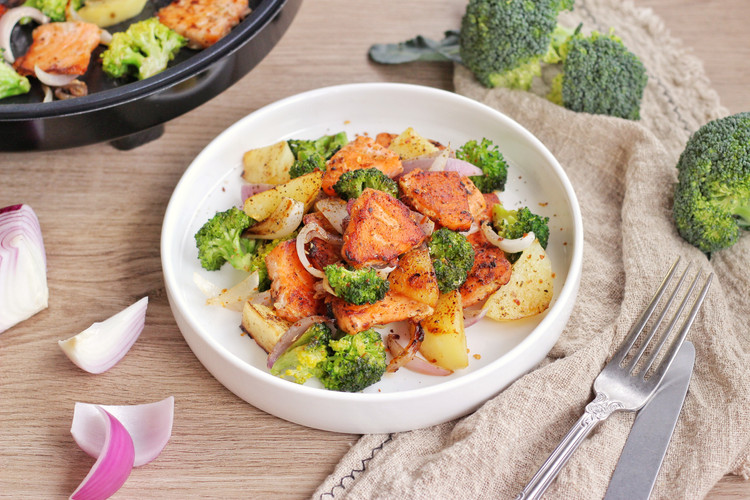Nutritional Value
The nutritional value of grilled salmon salad mainly comes from the main ingredient – salmon. Salmon is a rich source of protein, vitamins, and minerals, especially its abundant Omega-3 unsaturated fatty acids, which have excellent cardiovascular and brain health benefits. This fatty acid helps to lower the risk of heart disease and also improves cognitive function. Additionally, salmon contains a substance called astaxanthin, which plays an important role in skin health and fat metabolism.
Ingredients and Seasonings
The key to making grilled salmon salad lies in choosing fresh ingredients and appropriate seasonings. Fresh salmon should have firm flesh, bright color, and no unpleasant odors. Ingredients such as onions, lettuce, tomatoes, and cucumbers should be fresh, pest-free, and brightly colored. Seasonings include high-quality salad dressing and olive oil that can enhance the flavor of the salad, while salt and black pepper can add layers of flavor. Additionally, according to personal taste, some herbs such as rosemary or mint can be added.
When selecting seasonings, it is important to choose natural, low-fat options to avoid processed foods. For example, low-fat salad dressing or lemon juice can be used instead of some of the salad dressing. Additionally, to maintain the healthiness of the salad, the intake of salt and sugar should be controlled to avoid over-processing.
Preparation Method
Preparing grilled salmon salad requires some skill and patience. Firstly, handling the salmon is crucial. The salmon should be cleaned, scaled, and gutted, then cut into appropriately sized pieces or slices. Next is the marinating or seasoning process. The cut salmon is placed in a bowl, seasoned with salt, black pepper, lemon juice or olive oil, and left to marinate for a period of time to absorb the flavors.
Then comes the grilling process. The salmon can be pan-seared or grilled in the oven. When pan-searing, the heat should be controlled to avoid burning or overcooking the salmon. When grilling in the oven, the temperature should be set at a suitable range, usually between 180°C and 200°C, and grilled for a period of time depending on the size and thickness of the salmon pieces, typically 10 to 15 minutes.
Finally, comes the assembly of the salad. The grilled salmon is placed in a salad bowl or other suitable container, then topped with sliced vegetables and other ingredients. Options for vegetables include lettuce, onions, tomatoes, cucumbers, etc. Additionally, some nuts or dried fruits can be added to enhance texture and nutrition. Finally, according to personal taste, salad dressing or other seasonings can be added for flavoring.
During the preparation process, attention should be paid to the freshness of ingredients and the combination of seasonings to ensure the flavor and nutritional value of the salad. Additionally, attention should be paid to cooking techniques and heat control to avoid damaging the nutritional value and texture of the salad.
Eating Instructions
Grilled salmon salad can be eaten directly or accompanied by other ingredients. As the salmon in the salad is grilled to a crispy texture, it is recommended to eat it by hand to fully experience its flavor and texture. Additionally, extra salad dressing or other seasonings can be added according to personal taste for flavor enhancement. As the salad is often served as an appetizer or part of a lunch meal, it can be paired with other main dishes or soups for a more comprehensive meal experience.
Notes
- Freshness of Ingredients: Ensure that all ingredients are fresh, especially the salmon. Unfresh salmon may contain harmful bacteria or toxins that pose a health threat.
- Allergy Considerations: If allergic to seafood, avoid consuming salmon salad. Allergy symptoms may include but are not limited to itchy skin, difficulty breathing, nausea, vomiting, etc.
- Alcohol Pairing: While some people may enjoy pairing alcohol with their salad, it is advisable to avoid drinking alcohol immediately after eating seafood. Some types of alcohol may enhance the effects of certain harmful substances found in seafood.
- Storage: If planning to save the salad for later consumption, store the ingredients properly to ensure their freshness. Fresh salmon should be stored in the refrigerator’s crisper drawer and thoroughly washed before use.
- Moderation: Although grilled salmon salad is a nutritious dish, it should not be overconsumed. Excessive intake of certain nutrients (such as fat and protein) may have adverse health effects.

